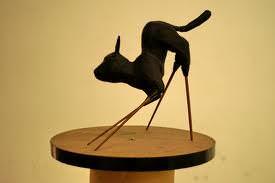How to Have More Lucid Dreams with Prospective Memory

Even though many people start out with the same background in dreaming, it is clear that some take to lucid dreaming much more easily than others. Why is this?
Many of us perform intuitive mental habits in our waking lives, and these can translate very simply to lucidity in the dream world. This gives some people a very distinctive headstart in their lucidity practice - and they don't even know they're doing it.
You could well be doing it yourself right now.
There are a number of practices and naturally occurring habits that fit this description but in this instance I'm talking about prospective memory: the forward-thinking ability to remember to remember.
The Little Voice of Recall
If you can remember to do something at a set time during your waking day without writing it down... then it's much more likely that you'll remember, when dreaming, to ask yourself: "Is this a dream?"
This of course is the basis of the reality check method - but how often do you perform reality checks in your dreams? Is it nearly enough?
By improving your prospective memory, you could remember to perform reality checks frequently - perhaps even on a nightly basis, leading to nightly lucid dream adventures.

Having good prospective memory is like hearing an alarm going off inside your head just when you need it. It shouts with an inaudible voice: REMEMBER TO DO THAT THING, NOW! It appears to come from nowhere, but in reality this is your unconscious returning a pre-arranged memory cue. Remarkably, as I'll show in a moment, it is often linked to an internal brain clock which boasts an accuracy that is almost to-the-minute.
Here, I'll show you how to improve your prospective memory and make your lucidity induction come more naturally. First, let's look at some common examples of prospective memory and see what you may already be doing.
Prospective Memory in Daily Life
I think that a natural prospective memory is more powerful among people who are highly conscientious and organized. The more you consider or worry about the consequences of forgetting to do something, the more motivated you are to remember.
We inadvertently train ourselves in prospective memory when we make formal appointments without writing them down, plan to catch a plane which requires good time planning, or do the weekly food shop without a shopping list (with those pesky sporadic purchases we have to make an effort to remember).
Here are some more examples of prospective memory in my daily life, and what I've observed about the nature of this curious mental trait.
- Taking a contraceptive pill - A lot of women are well practiced at this. At 6pm every day (or often just before) a mental alarm goes off in my head which reminds me to take my pill within the essential 3-hour window. I never programmed this alarm intentionally, it just happened after years of having a real alarm go off on my phone. Eventually I began pre-empting the phone alarm so I no longer needed it anymore. "Take your pill!" Says the little voice in my head. Sometimes I wake up in the night thinking "S**t I didn't take my pill!" And I go flying downstairs in the middle of the night in search of my handbag before realizing I took it on time as always. Yup, the effect can become so powerful that it wakes me up out of my sleep! The consequence of not taking this pill is so potentially huge that the alarm is extremely reliable; it's only ever once failed me in more than a decade. In fact, my prospective memory to take my pill is so strong that the alarm continued to go off in my head at 6pm every day while I was pregnant with Fox. So for nine months straight, even though I had zero need for this prospective alarm call, the effect persisted and I couldn't shut it off.
- Making an appointment - Sometimes I'm too slack to keep tabs on a diary, but ironically motivated enough to commit dates and appointments to memory so I don't forget them. Once again I'm relying on my prospective memory which has become so strong it can kick in weeks after making the original appointment. It flags the event with increasing intensity during the lead-up. Of course, we are nearing the territory of having something "in the back of your mind" - the difference with prospective memory is it kicks in without having the memory anywhere near your conscious awareness.
- Waking up at a certain time - As a teenager, I used to set my alarm for 7.30am on school days. It was pretty weird, then, when I started to wake up at 7.27am just minutes before the dreaded alarm call, thereby saving myself the shrill audible horror of another day beginning... This, I understand, is actually quite common and it's thanks to that internal brain clock I spoke of earlier that tracks time through the night, even when we are asleep and unconscious. Remarkable. Over the years, I found the effect so fascinating that I used to test my prospective memory with various challenges. "OK," I'd say in my head as I got into bed the night before, "it's 11pm now and I want to wake up at 5.30am and record one dream." That would happen. Then I'd set another mental alarm for 90 minutes later, in the attempt of coinciding with another period of REM sleep. The timing of REM is never that predictable but I have used this technique to significantly improve my dream recall.
So, prospective memory certainly has its uses for lucid dreamers.
Prospective Memory and Reality Checks
Of course, there's one other huge application for prospective memory in my life and that's doing reality checks. I need to remember to test my reality habitually through the day, so I can remember to do the same in my dreams.
Sean Kelly, the creator of Lucid Academy, recommends improving your prospective memory by committing to do reality checks every time you see a certain object, like a cat or a lock. Choose something you might see 5-10 times during your daily routine, rather than something that appears 20+ times, as that would be overkill. Then, every time you see that object, do a reality check.
Ask yourself, "am I dreaming?" Now, you have to really mean it and fully probe your self awareness in your environment. Don't just say "nope" and move on. It should be a deep, thoughtful exercise. If you're not entirely sure what that means, check out how to improve your self awareness as this will help define meaningful reality checks and awareness of your self.
To be habitually self aware in waking life means to be more self aware in your dreams.
Anchors and Mnemonics Devices
If you want to go all-out with the prospective memory technique, you can expand on this concept with methods straight out of NLP (or Neuro-Linguistic Programming). An anchor is, an Sean Kelly described, a link that reminds you of something. So here we have linked cats and locks to reality checks.
Sometimes, even with a solid, well-defined anchor in place, you may completely forget to do your reality check. You may get home and realize you actually saw two cats on your walk and completely failed to test your reality. No problem. You just need to set up a simple mnemonic device.
A mnemonic device is a memory cue that is visually intense and sparks the imagination into life. Think of a perfectly normal cat. Now, imagine it's carrying a giant oversized cardboard check on its back, struggling to bear the load which guarantees to pay Mr Cat the princely sum of $500,000.
You've just mnemonically linked "cats" and "checks" together in your mind using surreal imagery. So the next time you see a cat, you are more likely to recall this funny image, which in turn reminds you to perform your reality check. Bingo.

But we needn't be so literal. You can imagine that cat exploding, or walking on chopsticks, or running up and jumping into your arms and licking your face. (It depends on your personal relationship with cats.) As long as the cat's doing something surreal and unexpected, it creates a more powerful memory that will grab your attention and trigger that prospective memory cue.
Oh - and the next time you dream of a cat, be prepared for it to explode. That should trigger your reality check nicely. (I'm really a dog person.)
Final Thoughts
The good news is, developing your prospective memory does get easier.
"We are attempting to create a continuous thread in the unconscious mind," says Sean, "that is always present in the background, waiting to be activated at the appropriate time. As we work with this type of memory it becomes easier, because we create a groove in the unconscious mind."
Soon, this "groove" makes your prospective memory quite instinctive - so you're not even thinking about it anymore. And I'm confident you can reliably program your first reality check anchor within a few days. Also be sure to give the alarm call method a shot - because when you can wake yourself up with your brain's internal clock, you can then realize its true power...
















